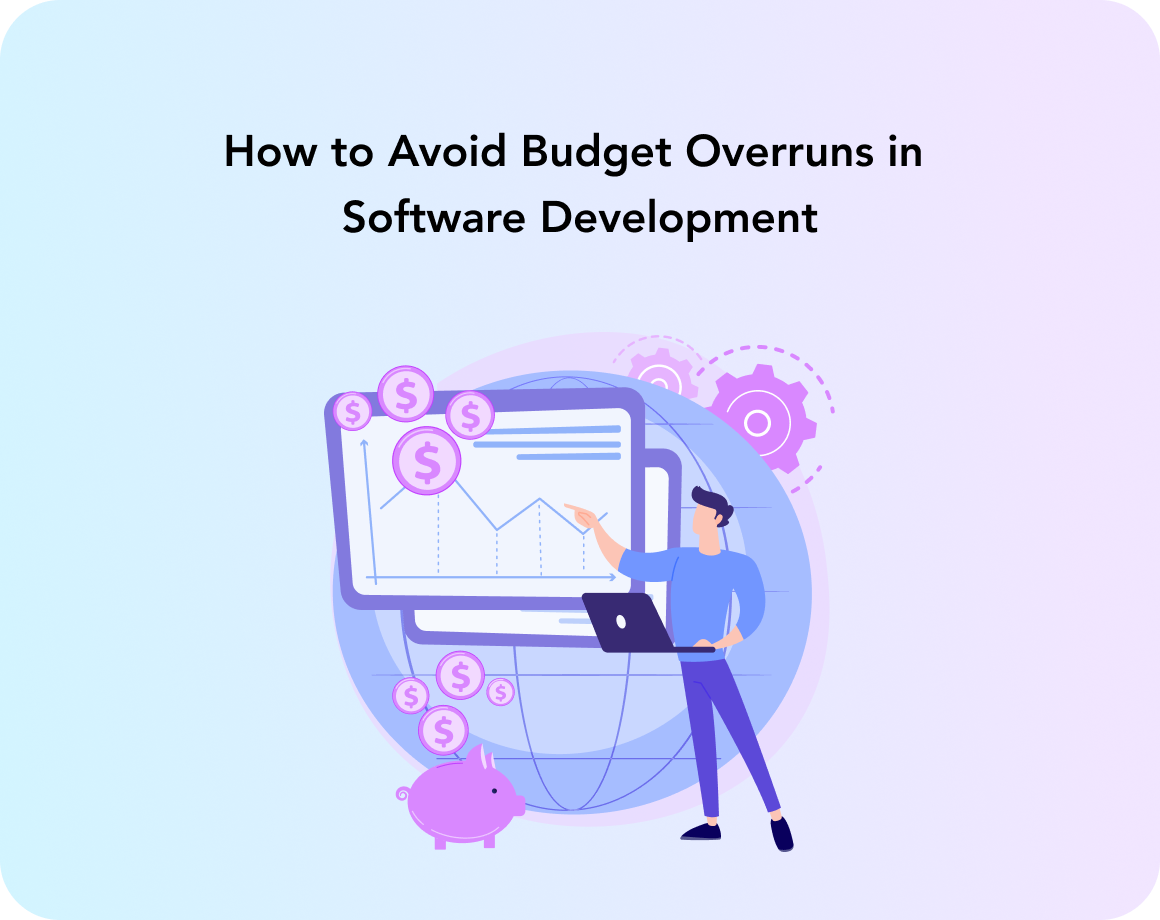Overstepping the project’s budget is one of the biggest fears of any software development stakeholder. Rightfully so: increasing the budget mid-project leads to stresses of resource repurposing, refusing some of the features, or finding additional funding. Add the frustration from ineffective project management and wrong estimations, and it becomes clear why cost overruns are a massive problem for software development teams.
Let’s explore what budget overruns are, which project management mistakes lead to blown-out project costs, and how to avoid falling out of the budget with 5 effective strategies.
What is a Budget Overrun in Software Development?
A budget overrun, also called a cost overrun, is a surge in budget spending on a project, including software development. A development team ends up spending more money on the project than planned and agreed upon in the beginning.
While a budget overrun is unpleasant and unpredictable, it is more common than one might assume. McKinsey found out that 66% of enterprise-level IT projects face cost overruns. Among those, large tech projects run 45% over budget and 7% over time, while delivering 56% less value than predicted.
With the increased volume of software development projects these days and the higher accessibility of development services for startups and small businesses, this number has likely only increased.
Ironically enough, it is startups and small businesses that often come to a development company with a strict budget and simply cannot afford to spend more than planned. That's why these businesses especially should be looking out for red flags indicating a potential cost overrun.
Top Reasons Why Tech Projects Face Budget Overruns
There are several reasons that might cause budget overrun. Let’s look into them.
Unrealistic schedule
Setting unrealistic project timelines, often based on optimistic guesses rather than data-driven analysis, is a significant factor contributing to budget overruns. When development teams are pressured to meet aggressive deadlines without considering the complexities of the tasks, corners may be cut, leading to quality issues, rework, and ultimately, increased costs.
It is a must that you and your team realistically evaluate the complexity of features and the UI/UX design customization level you would like to see. Empty promises of finishing the project in under 2 months can only lead to disappointment and extra money spent.
Lack of stakeholder engagement
When stakeholders are not involved from the outset and their feedback is not considered during the development process, the project might deviate from its intended path, leading to wasted efforts and additional expenses.
Every client has their own level of engagement that they find comfortable. Speaking from our experience, some clients would like to see daily reports and regularly communicate with developers directly, others find it enough to receive a monthly progress report and check in for project milestones. Both scenarios are totally fine but it’s critical that you take a look at the product from time to time and give you feedback, mostly when a milestone, like the wireframes stage in UI/UX design, is completed.
Scope creep
What started as a mobile app with 5 basic functions can easily turn into a complex product with 3 more features, including AI integration. This phenomenon is called scope creep. In fact, 34% of projects globally are influenced by scope creep. The initial project concept just doesn’t seem like enough anymore and it looks like that one extra feature won’t influence the project progress too much.
Scope creep can become a huge problem for your budget. Any project scope and budget are calculated ahead based on the client’s business and technological requirements. That’s why when the project scope and objectives are not well-defined or keep shifting, it becomes challenging to estimate the necessary resources accurately. This can lead to unforeseen expenses and delays as the project progresses.
As a client, you don’t necessarily need to have a long list of precise requirements. Your dedicated software development team can assist with drawing the product concept and deciding on the requirements for the designers and developers. The important part here for you is to approve the requirement list and stick to it throughout the project as any minor change later on with extended work possibly leads to budget overrun.
Lack of risk management
The world would be just too perfect if everything always went as planned. Unfortunately, we are not yet living in a predictable utopian world, and all kinds of surprises can happen to your project. A software development vendor might need to change a team member, users might not enjoy a certain feature during the testing stage, or a new similar solution might enter the market right when you are about to launch.
Taking into account all the possible worst-case scenarios and various delays significantly reduces overspending and delays. An experienced project manager knows how to handle different situations that influence the project flow and how to minimize the negative effects of those. A lack of understanding of possible risks and their mitigation ways is an invitation for budget overruns.
Unexperienced software development team
Making precise scope estimations, finishing milestones on time, and choosing the most effective tech stack and project methodology comes from experience. A team that worked on dozens of projects from a variety of domains might manage their time and resources better than newcomers who are only learning how to collaborate and what are the specifics of software development for different industries.
Your choice of software development partner will in a large part determine the project’s success. An inexperienced team might struggle with accurately estimating the time and resources required for various tasks, leading to underestimated budgets and eventual overruns.
5 Working Strategies to Avoid Budget Overruns
Fortunately, there are efficient strategies for avoiding budget overruns. By applying these strategies, your chances of spending more than planned come closer to zero.
Set clear requirements
Clear and well-defined project requirements are the foundation of a successful project. If the team knows exactly the number of features required, their complexity, design customization level, software performance expectations (e.g. how many people can access the platform at once), and other parameters, there is a smaller space for detours in the planned work scope and, as a result, overrunning your development budget.
At Perpetio, we assist clients in drafting precise tech and business requirements, even if they lack experience or a clear vision. It’s totally okay to contact us with just an idea for an app. But it’s critical to bring this idea into a definite list of requirements before kicking off the work. Our team of experts consults clients beforehand to identify and define project scope, objectives, and functionalities, ensuring that everyone is on the same page from the start.
Ask for a detailed project proposal and quote
Before the project begins, request a detailed project proposal and a comprehensive cost estimate from the development team or vendor. This proposal should outline the scope, deliverables, timeline, and cost breakdown. Review it carefully to ensure that all aspects of the project are adequately covered. Having a clear agreement in place helps prevent misunderstandings and scope changes that could impact the budget later.
For example, when partnering with Perpetio, clients receive a comprehensive project proposal that outlines every aspect of the project. Based on your business needs, technical requirements, and resources, we come up with a project proposal that outlines project milestones, deliverables for each milestone, time estimations, and cost per hour.
Communicate with the team regularly
While staying aside from the development process and leaving the management hustle to someone else is the basic principle of the outsourcing model, some level of involvement is necessary for the project's success.
Even though you expressed your expectations during the requirement drafting stage, your feedback is much needed after each milestone is completed, so that the final result matches your vision and no redoes are needed.
At Perpetio, we facilitate various avenues for communication. Our clients have the opportunity to have one-on-one discussions with our project managers, who serve as dedicated points of contact. Regular status updates, progress reports, and milestone notifications keep clients well-informed about the project's advancement.
We also encourage clients to join project update calls and meetings, providing direct insights into the project's evolution. These interactions foster collaboration and offer the chance to address any concerns or questions promptly. By participating in these calls, clients can contribute their expertise and decision-making, promoting a deeper understanding of the project's progress.
Use project management tools
Project management tools provide valuable assistance in tracking progress, managing tasks, and monitoring resource allocation. These tools offer visibility into how the project is advancing, allowing the team to identify potential bottlenecks or deviations from the plan. By using these tools to manage tasks, timelines, and resources, a project manager can make informed decisions to keep the project on track and within budget.
At Perpetio, we make project management easy and accessible with user-friendly tools like Jira. It's like having a virtual hub where everyone can keep an eye on what's happening. Jira helps us track tasks, keep timelines in check, and make sure resources are used wisely. For you, it's like peeking into the workshop – you can see what's being done, how it's going, and where things might need a little nudge. With Jira on our side, we're all on the same page, making sure the project stays on track and within your budget.
Collaborate with a reliable software vendor
Chaos in your software development team almost definitely means cost overruns. Unestablished processes, communication gaps, lack of experience in project management and technology, and unfamiliarity with the particular industry’s software requirements all lead to prolonged projects and cost overruns.
A reliable and experienced software vendor is the key to success if you want to receive your software solution on time, within the discussed budget, and, most importantly, with top quality. Before signing any contracts, make sure to check the company’s rating and reviews, look through their portfolio, and ask all the tricky questions in an interview. Trust us, investing more time into selecting a reliable vendor will save your budget from overruns and make the upcoming collaboration stress-free.
Consider Perpetio Your Trusted Partner
Choosing the right software vendor is like finding a co-pilot who's got the experience to navigate any turbulence. We understand the importance of accurate cost estimates and smart risk management – it's like having a financial safety net. We don’t just write code or design pages – our approach is studying your business specifics, audience, and priorities to build a product that works to reach your goals.
With us, you're not just getting a vendor; you're getting a partner who's got the expertise to tackle challenges head-on and keep your project sailing smoothly. When the waters get rough, we're the ones who can steer you away from budget overruns and guide you toward a successful outcome.





